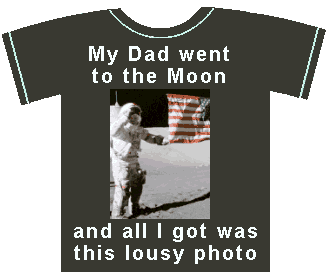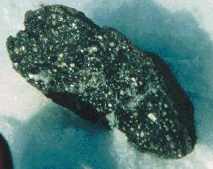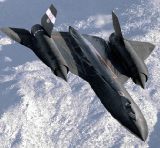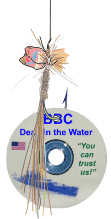More Apollo information

I thought my Science Challenge
#24 would be more than enough evidence that the Apollo moon landings
were faked. However, understanding that science challenge requires you
understand why the earth's sky is blue
during the day, and why stars cannot be seen at night in densely populated
cities.
I have discovered that there are very few people who understand why
nobody in a city can see stars at night. Therefore, I will provide some
more information about Apollo.
1) NASA wants to measure radiation
on the moon
NASA is planning to send astronauts to the moon by the year
2020. However, before they send people to the moon, they want to measure
the radiation levels on the moon with an unmanned probe named CRaTER:
science.nasa.gov/headlines/y2005/08sep_radioactivemoon.htm
Didn't NASA measure radiation levels in the 1960s?
NASA sent several Surveyor probes to the moon during the 1960s before
sending the Apollo astronauts:
nssdc.gsfc.nasa.gov/planetary/lunar/surveyor.html
NASA claims the purpose of the probes was to analyze the moon's surface.
At the time those probes landed on the moon, nobody knew whether the moon's
surface was hard enough for people to walk on. Some people wondered if
areas on the moon were covered with such a thick layer of powder that the
Apollo spacecraft would sink into it.
The Surveyor probes showed that it was possible to land a spacecraft
on the moon because the surface was crushed rocks, not deep, soft powder.
NASA admits that the Surveyor 6 measured solar protons and cosmic rays:
nssdc.gsfc.nasa.gov/database/MasterCatalog?sc=1967-112A&ex=2
What did the probe determine? Were the solar protons and cosmic rays
at such a low level that the astronauts would be safe? Why is NASA so secretive
about radiation levels in outer space?
After discovering that the moon was safe to walk on, NASA claims to
have sent six teams of astronauts to the moon. They landed in six different
locations. However, none of them bothered to measure the radiation.
NASA claims that the Apollo astronauts never bothered to measure radiation
levels because they were on the moon for only a couple days. A more likely
explanation for why the astronauts never measured radiation levels on the
moon is because they never went to the moon.
Furthermore, it is possible that the Surveyor probe discovered that
radiation levels on the moon were so high that no astronaut could possibly
survive in those thin spacesuits and that lousy lunar lander. Perhaps NASA
classified all the radiation measurements as “Top Secret” so that we do
not
realize that outer space is dangerous.
2) The 1969 press conference was psychotic

After Neil Armstrong, Michael Collins, and Buzz Aldrin returned
from the moon in 1969, they held a press conference to tell the world about
their incredible trip to the moon.
These three men just accomplished the most incredible feat the human
race has ever achieved. If you had been in their position, wouldn't you
have been excited, proud of America, and happy to describe your trip to
the moon?
The facial and body expressions of the astronauts suggest that they
are suffering from extreme emotional stress.
Why would they appear to be so nervous and awkward? NASA wants us to
believe that all of the astronauts are extremely introverted. But watch
the first few minutes of their interview, and ask yourself, are they really
introverted? Or are they suffering stress because they are lying about
going to the moon?
apollo11_press_conference.wmv 
3) All Apollo astronauts are
psychotic
All 12 Apollo astronauts remained hidden from the public after
coming back from the moon. NASA wants us to believe that all 12 astronauts
are too shy to give interviews.
Neil Armstrong is the best example of this. Here is an article about
his bizarre behavior from The Cincinnati Enquirer:
enquirer.com/editions/1999/07/18/loc_neil_armstrong_the.html
From the book One
Giant Leap by Leon Wagener, page 298 we have another description of
this psychotic astronaut:
| When Neil started as a professor at the University of Cincinnati in
1970, news executives from the area's radio, TV, and print media were summoned
to a downtown restaurant to hear an ultimatum: they were not to request
interviews with the space hero who would be living in their midst, because
none would be granted; they were to totally ignore his presence and not
consider it legitimate news. Amazingly, the group agreed—with one exception.
Lawrence H. Rogers, then head of Taft Broadcasting Corporation, owners
of a chain of television and radio stations in the region, howled in protest.
"The reason they gave was that Neil had no secretary and would be overwhelmed
with requests. I raised my hand and said, 'That's the most preposterous
thing I have ever heard.' I told them Armstrong was the most famous explorer
since Christopher Columbus; it would have been criminal journalistically
to not write about him and praise what he had accomplished." |
What are the chances that 100%
of the Apollo astronauts are so introverted that they are incapable of
visiting children in school, going onto television shows to talk about
the moon, and giving interviews to reporters?
|
Update:
Neil Armstrong may no longer be the most psychotic astronaut!
Did you hear about Lisa Nowak, Clark McClelland, or Ed Mitchell? I have
some information about them on this
page. |
 |
4) The moon is not bright
Many people dismiss my Science
Challenge #24 on the grounds that the moon's surface reflects so much
light that the astronauts could not see stars.
I thought this Science Challenge
#25 might help, but most people cannot understand that one, either.
So I will tell you the answer: the moon is not
a bright object.
It is easy to measure the level of reflected light from the moon, and
from that you can determine what percentage of the sunlight the moon is
reflecting. You will discover that the moon does not reflect very much
sunlight.
There is a very simple description from NASA that everybody can understand:
| ...the moon is about the poorest reflector in the solar system. The
amount of light reflected by a celestial object is called the albedo (Latin:
albus, white). The moon reflects only 7% of the sunlight that falls upon
it, so the albedo is 0.07 |
liftoff.msfc.nasa.gov/academy/universe/moon.html
This means that astronauts on the moon would not
be overwhelmed with the brightness of the lunar surface. Rather, they would
be amazed at how dark the surface is.
5) The technology was too primitive
in the 1960's
 The
computers of the 1960's would not qualify as computers by today's standards.
Rather, they were “electronic adding machines”. The
computers of the 1960's would not qualify as computers by today's standards.
Rather, they were “electronic adding machines”.
Manufacturing technology was horrible
by comparison to what we have today because they did not have computer-controlled
milling machines or lathes.
I have a PDF file with information:
ApolloMoonHoax.pdf
6) U2 pilots can see stars
In my PDF file (see link above) I point out that a U2 pilot
said that when he climbs to high altitudes the sky becomes dark, the stars
become brighter, and more stars become visible:
“The air is so much clearer up there;
you can see what seems to be 10 times more stars. They just carpet the
sky."
The original web page is gone, but you can still get it at the Internet
archive by clicking here.
Also, I have a copy here.
Everybody can see stars... except
the Apollo astronauts!
7) NASA wants to crash a probe into
the moon
In April 2006 NASA announced a plan to send a probe
to the moon in 2008 to determine if there is water on the moon.
Didn't NASA already analyze the 400
kilograms of moon rocks that 6 teams of astronauts brought back to
the Earth from 6 different locations on the moon?
Furthermore, this latest probe will crash
into the moon, not land gently!
NASA claims to have the technology to put men on the moon, and bring
them home again, so why are they planning a primitive, destructive crash?
8) Hubble telescope looks at
moon
In this
amazing report, we discover that NASA is using the Hubble telescope
to look at ultraviolet light reflected from moon in order to determine
what type of minerals are on the surface of the moon.
Do I have to repeat this:
Didn't NASA already analyze the 400
kilograms of moon rocks that 6 teams of astronauts brought back to
the Earth from 6 different locations on the moon?
NASA wants us to believe that those 400 kilograms is not enough; that
the experiments conducted by the astronauts is not enough. Do you believe
that looking at the moon with a telescope does a better job than 12 men
on the moon?
9) Moon rocks are in Antarctica?
Barbara Cohen, a researcher from the University of New Mexico,
was picking up rocks in Antarctica. She sent them to Houston, Texas for
an analysis.
The scientists in Houston discovered that one of the Antarctic rocks
closely matched the NASA moon rocks.
The scientists then concluded that one of the rocks from Antarctica
was actually from the moon:
astronomy.com
id=4526
How did rocks from the moon get in Antarctica?

Update: I made a science
challenge about this question:
Science_Challenge_27.html
NASA and Ms. Cohen want us to believe that a big meteor crashed into
the moon a while ago, and pieces of the moon were sent flying into space.
A few of those pieces landed in Antarctica.
Take a look at how far away the moon is from the earth. If it were true
that rocks were ejected from the moon with such velocity that they could
escape the moon's gravity and fly out into space, what are the chances
that any of them would survive the fall through the atmosphere and land
on tiny Antarctica hundreds of thousands of kilometers
away? Furthermore, the rock has to land in a location where
humans can find it many years later.
A more sensible explanation is that the NASA moon rocks were rocks
from Antarctica.
Therefore, when someone travels to Antarctica and sends rock samples
to Houston, Texas for analysis, some of the rocks will closely match the
Apollo moon rocks.
10) Lunar rocket was silent, too many
photos...
Other people who looked at Apollo found other problems. For example, Jack White
counted the photos taken by the astronauts on the moon, divided it by the time
they were on the moon, and points out that they took too many photos:
aulis.com/skeleton.htm
Note: keep in mind that I have discovered that most of the "truth seekers" have turned
out to be "Wolves In Sheep's Clothing" who are trying to control their opposition.
Instead of trying to expose the Apollo Moon landing hoax,
the Holocaust lies, the 9/11 attack, etc., they release only some information about
their crimes in order to attract your attention to their website, and then they mix in some propaganda,
and they suggest you visit other sites that are also under their control so that you remain
in their network of websites, thereby preventing you from getting an accurate understanding of
how extensively the Jews and Israel are involved with these crimes. They shift the blame to the CIA,
the military, the corporations, and the Bush family.
So be suspicious of everybody!
Bill Kaysing or Bart Sibrel (I forget which) pointed out that the rocket
engine on the lunar lander was silent. You can listen to it (actually,
you can not listen to it) at this site,
where an excerpt of the Official Apollo Video is available:
australiafreepress.org/articles/Apollo/apollo.htm
It is so quiet that it appears the astronauts are in a protected Hollywood
studio.
|



 The
computers of the 1960's would not qualify as computers by today's standards.
Rather, they were “electronic adding machines”.
The
computers of the 1960's would not qualify as computers by today's standards.
Rather, they were “electronic adding machines”.


